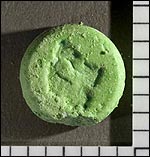Clandestine chemistry
Clandestine chemistry refers to the illegal manufacture of drugs, explosives, and other chemicals in secret laboratories. This practice is often associated with the production of narcotics, stimulants, and psychedelic drugs for the purpose of distribution on the black market. Clandestine chemistry operations vary in scale from small, personal-use labs to large-scale operations capable of producing significant quantities of illegal substances.
Overview[edit | edit source]
Clandestine chemistry is a form of illegal activity that involves the synthesis of controlled substances outside of legal and regulatory frameworks. Individuals involved in this practice, often referred to as "cooks," typically operate in hidden or secluded locations to avoid detection by law enforcement. The chemicals used in the production of illegal drugs can be hazardous, posing risks not only to the individuals involved in their manufacture but also to the environment and the general public.
History[edit | edit source]
The history of clandestine chemistry is closely tied to the history of drug prohibition and the War on Drugs. As laws and regulations around certain substances have tightened, the demand for these substances has not diminished, leading to the rise of underground labs. The 1980s and 1990s saw a significant increase in the number of clandestine labs in the United States, particularly those producing methamphetamine.
Common Substances Produced[edit | edit source]
- Methamphetamine: A powerful central nervous system stimulant, often produced in "meth labs."
- MDMA (Ecstasy): A psychoactive drug primarily used for recreational purposes, known for its empathogenic effects.
- LSD (Lysergic acid diethylamide): A potent hallucinogen, synthesized from lysergic acid.
- Cocaine: Although primarily extracted from coca leaves, clandestine labs may be involved in its purification and processing.
- Heroin: Derived from morphine, which in turn is extracted from the opium poppy. Clandestine labs may be involved in its synthesis from morphine.
Risks and Hazards[edit | edit source]
Clandestine chemistry poses significant risks, including:
- **Chemical Hazards**: The handling of volatile and toxic chemicals without proper safety measures can lead to explosions, fires, and exposure to harmful substances.
- **Environmental Damage**: The disposal of chemical waste from drug production can contaminate soil and water sources.
- **Legal Consequences**: Individuals caught manufacturing illegal substances face severe legal penalties, including imprisonment.
Detection and Enforcement[edit | edit source]
Law enforcement agencies use a variety of techniques to detect and dismantle clandestine labs, including surveillance, informants, and analysis of chemical purchases. The United States Drug Enforcement Administration (DEA) and local police departments often work together in these efforts.
In Popular Culture[edit | edit source]
Clandestine chemistry has been depicted in various forms of media, most notably in the television series Breaking Bad, which follows the story of a high school chemistry teacher turned methamphetamine producer.
Conclusion[edit | edit source]
Clandestine chemistry remains a challenge for law enforcement and public health officials worldwide. Efforts to combat the production of illegal substances involve a combination of legal, educational, and social strategies aimed at reducing demand and providing support for those affected by drug addiction.
Search WikiMD
Ad.Tired of being Overweight? Try W8MD's physician weight loss program.
Semaglutide (Ozempic / Wegovy and Tirzepatide (Mounjaro / Zepbound) available.
Advertise on WikiMD
|
WikiMD's Wellness Encyclopedia |
| Let Food Be Thy Medicine Medicine Thy Food - Hippocrates |
Translate this page: - East Asian
中文,
日本,
한국어,
South Asian
हिन्दी,
தமிழ்,
తెలుగు,
Urdu,
ಕನ್ನಡ,
Southeast Asian
Indonesian,
Vietnamese,
Thai,
မြန်မာဘာသာ,
বাংলা
European
español,
Deutsch,
français,
Greek,
português do Brasil,
polski,
română,
русский,
Nederlands,
norsk,
svenska,
suomi,
Italian
Middle Eastern & African
عربى,
Turkish,
Persian,
Hebrew,
Afrikaans,
isiZulu,
Kiswahili,
Other
Bulgarian,
Hungarian,
Czech,
Swedish,
മലയാളം,
मराठी,
ਪੰਜਾਬੀ,
ગુજરાતી,
Portuguese,
Ukrainian
Medical Disclaimer: WikiMD is not a substitute for professional medical advice. The information on WikiMD is provided as an information resource only, may be incorrect, outdated or misleading, and is not to be used or relied on for any diagnostic or treatment purposes. Please consult your health care provider before making any healthcare decisions or for guidance about a specific medical condition. WikiMD expressly disclaims responsibility, and shall have no liability, for any damages, loss, injury, or liability whatsoever suffered as a result of your reliance on the information contained in this site. By visiting this site you agree to the foregoing terms and conditions, which may from time to time be changed or supplemented by WikiMD. If you do not agree to the foregoing terms and conditions, you should not enter or use this site. See full disclaimer.
Credits:Most images are courtesy of Wikimedia commons, and templates, categories Wikipedia, licensed under CC BY SA or similar.
Contributors: Prab R. Tumpati, MD




